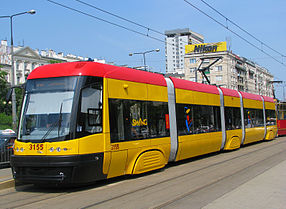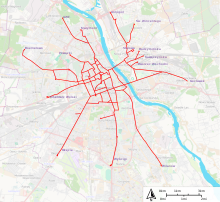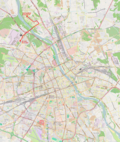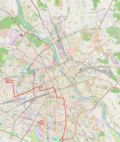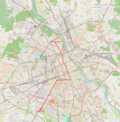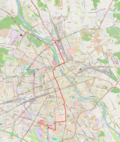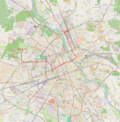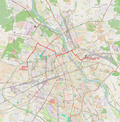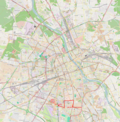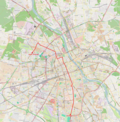Warsaw tram
| Warsaw tram | |
|---|---|
| Basic information | |
| Country | Poland |
| city | Warsaw |
| opening | December 11, 1866 |
| operator | Tramwaje Warszawskie Sp. Zoo |
| Transport network | ZTM |
| Infrastructure | |
| Route length | 125.3 km |
| Track length | 240 km |
| Gauge | 1435 mm ( standard gauge ) |
| Depots | 4th |
| business | |
| Lines | 24 |
| Line length | 348 km |
| Cruising speed | 18.1 km / h |
| vehicles | 415 Konstal 105N 30 Konstal 116 143 PESA 120N / 120Na 50 Pesa 128N 30 Pesa 134N |
| statistics | |
| Passengers | 195 million per year (2010) |
| Mileage | 26.4 million km per year |
| an older network map of the Warsaw tram | |
The Warsaw tram ( Polish : Tramwaje Warszawskie ) is a 120-kilometer system that covers a third of the urban area of the Polish capital Warsaw and reaches half of the population. 863 trams run on it and in terms of route length it is the third largest network in the country after the tram in the Upper Silesian industrial area and the Łódź tram . The network comprises about 30 lines, the part of the transport network Zarząd Transportu Miejskiego w Warszawie are (ZTM). Tramwaje Warszawskie Sp. Zoo has been the operator of the tram network since 1994 .
history
Horse tram

The history of tram traffic in Warsaw dates back to 1866, when a six-kilometer horse-drawn tram line was built for freight and passenger traffic between the Vienna train station and the Wilna and Terespol train stations on the other side of the Vistula . This made it possible to circumvent the restrictions imposed by the Russian occupation forces, which for strategic reasons prohibited the construction of a railway bridge over the Vistula. In 1880, a second line was built with Belgian capital to meet inner-city transport needs. The Belgian company expanded its route network in a short period of time and in 1882 took over the route between the stations, which had lost its original function after a railway bridge was built in 1875. In 1900 the city bought the entire tram system, which at that time comprised 30 kilometers of track, 234 trams and 654 horses running 17 lines. In 1903, plans began to electrify the tram, which was carried out until 1908.
Interwar period
The development stagnated in the following ten years, in which only a few short routes were built. After the First World War , the tram network grew rapidly with increasing numbers of passengers and reached the outskirts of the city. In 1939 it reached a network length of 60 kilometers served by 757 trams. In 1927 a private suburban railway called EKD (now Warszawska Kolej Dojazdowa ) was built, which connects several neighboring cities with downtown Warsaw and used electric railcars that were larger and heavier than trams. The route has a shorter distance between stops and runs in the city in the street space. Nevertheless, it was incompatible with the Warsaw tram, as its gauge was 1435 millimeters, while the tram still used the Russian broad gauge from the occupation. In 1925 the Warsaw Tram Company made the decision to build an underground network, but due to the Great Depression the construction of the Warsaw Metro was postponed. In 1938 the idea was resumed but dropped again due to the outbreak of World War II .
Second half of the 20th century
During most of the German occupation , the tram remained in operation, even if its state of maintenance gradually deteriorated. The operation then ended with the Warsaw Uprising in 1944, after which the entire infrastructure was systematically destroyed . It was rebuilt relatively quickly after the war. Since the network was practically rebuilt, the opportunity was used to change the gauge from 1525 mm to 1435 mm ( standard gauge ). In the 1950s and 1960s, routes to the newly built prefabricated building districts in the Soviet style and industrial plants were built. In addition, new railcars based on the PCC cars were introduced. With no subway network and limited ownership of private automobiles, the tram remained the backbone of Warsaw's traffic. Nonetheless, in the 1960s, the political decision was made to increase reliance on Russian petroleum imports while Polish coal was to be exported to Western Europe for hard currency procurement. As a result, new parts of the city were connected to the city center by bus routes rather than trams, and some of the existing routes were closed.
present
After 1989, the Warsaw tram initially received little investment, as a large part of the city's budget was used to build the first underground line. Since 2005 the situation has changed with the purchase of new rolling stock, the modernization of important routes and the installation of a dynamic passenger information system . The plans also include intelligent traffic control with traffic light priority and new lines. In August 2008, the delivery of 186 fully low-floor , air-conditioned tram cars was put out to tender. This will result in a serious change in the appearance of the Warsaw tram.
After 2000, two new tram lines were built. The first route, which opened on December 23, 2014, runs to the northern part of the city over the currently Maria Skłodowska-Curie Bridge over the Vistula. It connects the rapidly growing satellite town of Tarchomin on the northeastern outskirts with the terminus of the M1 metro line , Młociny. The second new line, which went into operation on February 14, 2015, is located in the west of the city. It is a short stretch that connects two existing lines to complete the west bypass and thus create a direct link between two districts.
A tram connection to Miasteczko Wilanów is to be built from 2019 to 2021 .
vehicles
| image | Type | number | description |
|---|---|---|---|
 
|
Konstal 105Na and derived from it, FPS 123N |
202 | The most common type in Warsaw. Produced from 1977 to 2007. Based on the electrical equipment of the 13N in a lighter body. More efficient electrical systems were installed later. Mostly used in double traction, but can also be found in triple and single traction. |

|
Konstal 112N Konstal 116N / 116Na |
30th | In 1995, a single prototype of the partially low-floor two-part articulated multiple unit Konstal 112N was built. Further cars were produced between 1998 and 2000, expanded to three car parts under the designation 116N / 116Na. |

|
PESA 120N | 15th | Modern fully low-floor five-part articulated railcar called Tramicus , manufactured by PESA in Bydgoszcz in 2007 . The reason for the order was the modernization of the most important east-west connection via Jerusalemer Allee . |

|
PESA 120Na | 186 | Further development of the PESA 120N, called Swing . From 2010 to 2013, 180 one-way vehicles and 6 two-way vehicles were put into operation. |

|
PESA 128N | 45 | From 2014 to 2015 built by PESA, five-part low-floor articulated multiple unit for bidirectional operation, called Jazz Duo . |

|
PESA 134N | 30 (ordered) | Three-part one-way vehicle called Jazz . Delivery started in 2015. |
Lines
This table lists the Warsaw tram lines as of 2018. Due to construction work, there may be deviating lines.
Web links
- Official website of the operator Tramwaje Warszawskie (Polish)
- Tramwar - Private website about the Warsaw tram (Polish)
- Tram in Warsaw (German / English)
- The Warsaw tram network
Individual evidence
- ↑ Tramwaje Warszawskie Sp. Z oo - Informacje ogólne: Stan inwentarzowy taboru . Tw.waw.pl. Archived from the original on September 18, 2012. Info: The archive link was automatically inserted and not yet checked. Please check the original and archive link according to the instructions and then remove this notice. Retrieved May 4, 2011.
- ↑ Tramwaje Warszawskie Sp. Z oo - Informacje ogólne: Wskaźniki eksploatacyjne . Tw.waw.pl. Archived from the original on June 22, 2008. Retrieved June 12, 2009.
- ↑ Tramwaje Warszawskie Sp. Z oo - Mapa strony . Tw.waw.pl. Archived from the original on January 9, 2010. Retrieved June 12, 2009.
- ↑ Tramwaje w Wilanowie w 2020? Powstanie trasa za 300 mln złotych. In: warszawa.naszemiasto.pl. April 10, 2015, accessed September 15, 2018 (Polish).
- ↑ http://www.ztm.waw.pl/rozklad_nowy.php?c=182&l=1
